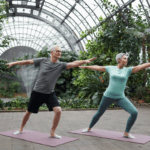Coming Soon: E-book about Kundalini Yoga - Sign up here to be among the first to get it!
Sanskrit: Matsyasana
Type: Supine Pose
Chakra Involved: Crown Chakra (Sahasrara Chakra), Third Eye Chakra (Ajna Chakra), Throat Chakra (Vishuddha Chakra)
Fish Pose (Matsyasana)
Fish Pose, or Matsyasana, is a beautiful and effective backbend that opens up the chest, throat, and shoulders while stretching the muscles of the front neck and the hip flexors. It’s known for its ability to improve posture, stimulate the abdominal organs, and relieve tension in the neck and shoulders. Traditionally, it’s also said to promote healthy thyroid function due to the stretch in the neck. This pose offers a counter-stretch to many forward-bending poses and can be particularly refreshing after long periods of sitting or standing.
Starting Position
Begin by sitting on the floor with your legs extended straight in front of you. Place your hands on the floor behind you, fingers pointing towards your feet, and lean back slightly, resting on your forearms and elbows.
Step-by-step Instruction
- Prepare Your Base: With your forearms and elbows pressed against the floor, slide your body forward to slightly curve your back, and then recline back onto your elbows. Ensure your legs remain together and active throughout the pose.
- Arch Your Back: Press into your elbows and forearms to arch your back, lifting your chest towards the ceiling. Keep your thighs and buttocks engaged to protect your lower back.
- Release Your Head Back: Gently tilt your head back, open your throat, and rest the crown or the back of your head on the floor, depending on your neck flexibility. Ensure there is no strain; the focus is on the lift and openness of the chest.
- Adjust Arm Position: Extend your arms along the floor, palms facing down, or bring your hands together in a prayer position (Anjali Mudra) over your heart for a heart-opening variation.
- Hold the Pose: Maintain the pose for 15-30 seconds, breathing deeply. Feel the stretch across your chest, throat, and the front of your neck.
- Engage Throughout: Keep your legs and core engaged to support the backbend and protect your spine.
To Release the Pose
- Support Your Neck: First, press firmly into your forearms and elbows to lift your head off the floor gently.
- Lower Your Torso: Use your arms to support your torso as you slowly lower your back to the floor.
- Relax: Once flat on the floor, hug your knees to your chest gently for a few moments to neutralize your spine.
Teacher’s Tip
- Neck Safety: Ensure students understand the importance of keeping the neck comfortable and avoiding strain. If a student feels any discomfort in their neck or throat, advise them to keep their head lifted, looking towards the ceiling, rather than dropping it back.
- Use of Props: For those with limited back flexibility or discomfort when arching, recommend placing a bolster or rolled-up blanket under the back at the level of the heart to provide support and lessen the intensity of the backbend.
- Breath and Expansion: Encourage students to focus on their breath, using it to expand the chest and ribs with each inhalation. This deep breathing enhances the therapeutic benefits of the pose, including stress relief and improved respiratory function.
- Modifications: For a more accessible version, keep the forearms on the ground to support the backbend, reducing the strain on the lower back and neck.
Fish Pose is a wonderful practice for opening the heart and stimulating the energy centers associated with communication and expression. Encourage students to approach the pose with patience and to respect their body’s limits.
Variations of Fish Pose (Matsyasana)
Fish Pose, or Matsyasana, offers several variations to accommodate different levels of flexibility, focus on specific areas of the body, or introduce new challenges. Here are some popular variations of Fish Pose along with instructions for each:
1. Supported Fish Pose
- Instructions: Place a yoga block, bolster, or rolled-up blanket under your back at the level of the heart. Lie back so that the prop opens your chest upward. Rest your arms on the floor, palms facing up, and relax your legs. This variation is excellent for those seeking a gentler backbend or working on opening the chest without straining the back.
2. Lotus Fish Pose (Padmasana Matsyasana)
- Instructions: Begin in Lotus Pose (Padmasana) with your legs crossed and feet on opposite thighs. Carefully lean back onto your forearms and elbows, then arch your back and rest your head on the floor, as in the traditional Fish Pose. This variation adds a hip opener to the backbend, making it more advanced.
3. Fish Pose with Leg Lift
- Instructions: From the traditional Fish Pose, engage your core and lift your legs off the floor, bringing them to a 45-degree angle. Keep your legs straight and active. This addition introduces an abdominal strengthening component to the pose.
4. Fish Pose in Half Lotus (Ardha Padmasana Matsyasana)
- Instructions: Place one foot on the opposite thigh in a Half Lotus position before leaning back into Fish Pose. This variation provides a moderate hip opener along with the benefits of the backbend. Ensure to practice on both sides for balance.
5. Fish Pose with Bound Hands (Baddha Hasta Matsyasana)
- Instructions: Enter the traditional Fish Pose, then clasp your hands together behind your back, straightening the arms and lifting them slightly off the floor. This variation intensifies the shoulder and chest opening.
6. Revolved Fish Pose (Parivrtta Matsyasana)
- Instructions: From Fish Pose, keep your legs straight or in a crossed position. Twist your torso to one side, bringing one hand to the opposite knee and the other hand reaches back, touching the floor for balance. This twist adds a spinal rotation to the backbend, offering a gentle massage to the abdominal organs. Repeat on the other side.
Implementation Tips
- Warm-Up: Ensure you are properly warmed up before attempting these variations, especially for those that involve more advanced backbends or leg positions.
- Breathing: Maintain steady, deep breaths throughout each variation to help deepen the pose and increase its benefits.
- Listen to Your Body: Choose the variation that best suits your current level of flexibility and strength. Avoid any movements that cause pain or discomfort.
- Use Props: Don’t hesitate to use props like blocks, bolsters, or blankets to make the pose more accessible and comfortable. Props can help maintain proper alignment and prevent strain.
- Focus on Sensation: Pay attention to the sensations in your body, focusing on opening the chest and lengthening the spine rather than achieving the deepest possible backbend.
Exploring these variations can deepen your practice of Fish Pose, allowing you to experience its benefits in new and diverse ways while accommodating your body’s needs and abilities.
FAQs About Fish Pose
Fish Pose (Matsyasana) is a backbend that stretches and stimulates the front of the body, including the throat, chest, abdomen, hip flexors, and intercostals (muscles between the ribs). It encourages deep breathing, improves posture, and counteracts the effects of prolonged sitting or forward bending. By opening up the chest and throat, it also promotes the release of tension in these areas, which can be beneficial for respiratory function and emotional release.
Fish Pose should be approached with caution or avoided by individuals with certain conditions:
- Neck or Lower Back Injuries: Due to the extension of the neck and spine in Matsyasana, those with significant neck or lower back issues should avoid this pose.
- High Blood Pressure: The intense stretch in the neck area may affect blood pressure; thus, those with high blood pressure should proceed with caution or consult a healthcare provider.
- Hernia or Peptic Ulcers: The pose puts pressure on the abdomen, which might aggravate these conditions.
- Migraines: People experiencing migraines may find that the pose exacerbates their symptoms.
Matsyasana offers several therapeutic benefits, including:
- Improved Posture: By stretching the front body and strengthening the muscles of the back and neck, it helps counteract poor posture.
- Enhanced Breathing: The pose opens the chest and lungs, allowing for deeper breaths, which can help improve respiratory function.
- Relief from Tension: It can release tension in the neck and shoulders, areas where stress commonly accumulates.
- Stimulation of Abdominal Organs: The stretch also benefits the organs of the abdomen, aiding digestion and relieving constipation.
- Emotional Release: Opening the chest is associated with releasing emotional barriers, fostering a sense of openness and vulnerability.
Fish Pose is primarily associated with the Throat Chakra (Vishuddha Chakra). The throat chakra is the center of communication, expression, and truth. By opening the throat area, Matsyasana can stimulate the throat chakra, encouraging better communication and self-expression, and fostering a sense of balance within this energy center. Additionally, because the pose also opens the heart area, it can indirectly influence the Heart Chakra (Anahata Chakra), promoting emotional release and compassion.




